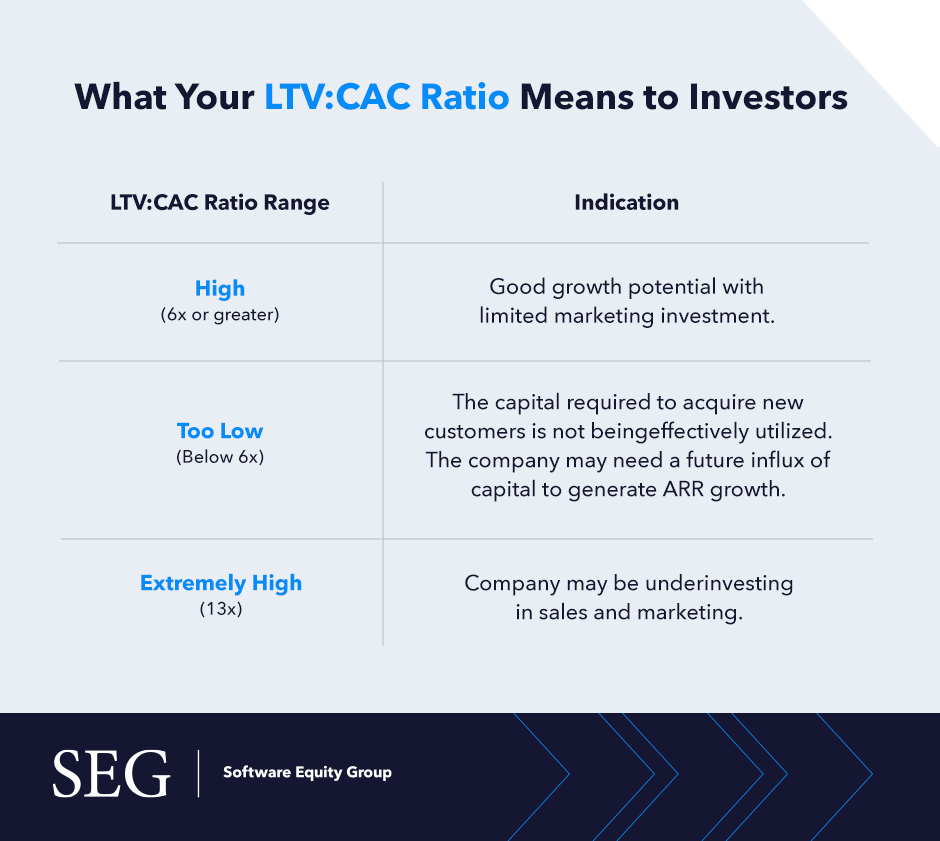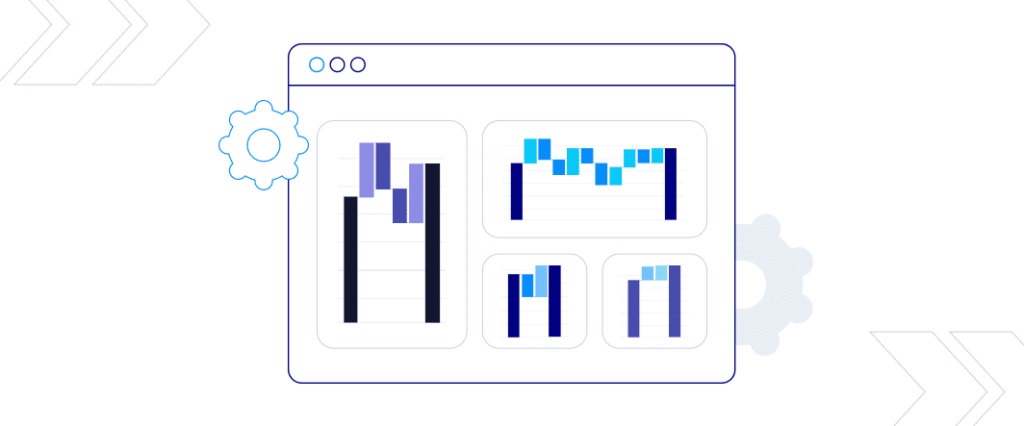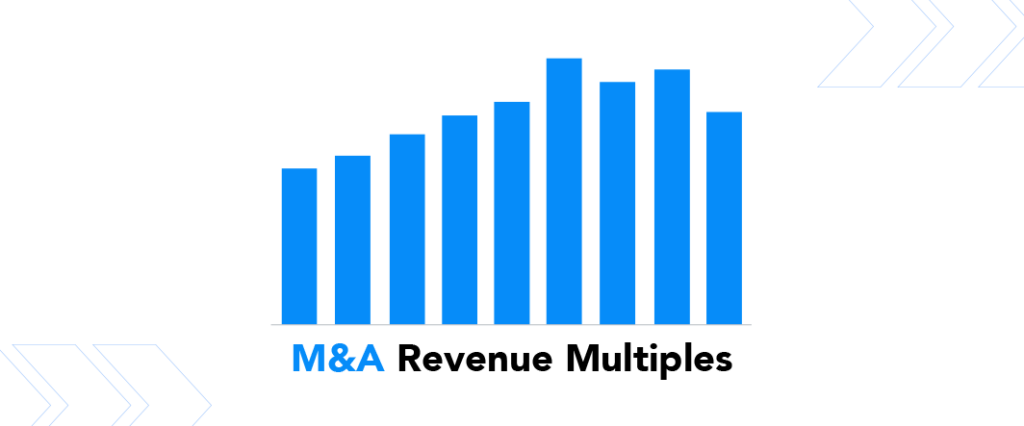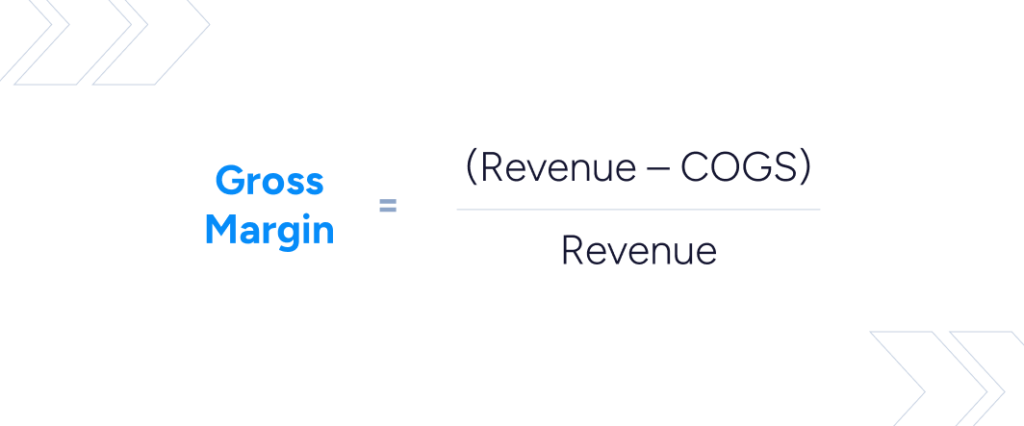- Company
Featured Resource
CLIENT STORYModern Message
To Real Estate
Giant RealPage
- Sectors
Featured Industry Report
EXPERT SERIESManufacturing Software
Report – Part 2
- Research
Featured Resource
FEATURED REPORTThe SEG 2024
Annual SaaS Report
- Tools
Featured Resource
WHITEPAPER20 Factors to Track When Valuing Your
SaaS Company
- Blog
The Importance of LTV:CAC for SaaS Businesses

For software companies moving beyond their product development and early growth stages, efficient resource allocation and high customer retention are important drivers of growth. If the wrong customers are being targeted or retention rates are volatile, SaaS companies are missing key growth opportunities. One effective way of determining whether your company is set up for long-term growth is to calculate the LTV:CAC ratio.
Along with the many benefits a good ratio can have for your business, it also provides a great health check for CEOs planning for future M&A processes. Ultimately, knowing how to calculate LTV:CAC is an important skill for SaaS leaders and can provide valuable insight into a company’s financial performance.
Why LTV:CAC Ratios Are a Good Indicator for SaaS Growth Opportunities
The LTV:CAC ratio is one of the most critical indicators of future success and a key calculation used by investors to determine valuation for SaaS businesses. Simply put, the LTV:CAC ratio refers to the relationship between a customer’s lifetime value (LTV) and the cost to acquire that customer (CAC or customer acquisition cost).
For the typical high performing SaaS business, the gross profit generated by each customer must be meaningfully higher than the customer’s cost of acquisition. For investors, the LTV:CAC ratio is an indication of both customer profitability and marketing effectiveness.
Below we work through the calculations for LTV and CAC.
Calculate Customer Lifetime Value (LTV)
LTV is the gross profit a single customer is predicted to generate over their engagement with the company.
A customer’s gross profit is the revenue a customer generates net of the company’s cost to fulfill that revenue. Calculating a customer’s gross profit requires an understanding of the company’s gross margin, a percentage representing the revenue retained net of cost of goods sold (see our previous blog on What Every Software Executive Should Know About COGS). Calculating customer lifetime value also requires an understanding of how long a customer remains engaged with the company, which is known as the average customer lifetime. Your company’s retention rate, average annual recurring revenue (ARR), and gross profit margin are also good proxy metrics to use when determining a customer’s average lifetime. In this example, we use the average ARR, which refers to revenue that comes from subscription or maintenance fees for your offerings.
LTV = Average ARR X Gross Profit Margin / Churn Rate
Churn Rate = 1 – Retention Rate
Consider three similar SaaS companies and their respective LTV calculations:
| Average ARR | Gross Profit Margin | Churn Rate | Lifetime Value | |
| Company A | $20,000 | 85% | 13% | $130,796 |
| Company B | $50,000 | 80% | 13% | $307,692 |
| Company C | $50,000 | 80% | 5% | $800,000 |
Although both Company A and B have the same 13% churn rate, Company B has a higher average ARR than Company A, leading to a greater LTV. This is true even though Company A has a higher gross margin overall.
Here is a comparison of Company B and C: they have the same average ARR of $50,000 and the same 80% gross margin, but Company B has a churn rate of 13% versus Company C’s 5% churn rate. This means Company B is retaining significantly fewer customers than Company C, resulting in Company B having a lower LTV relative to Company C.
In short, a company with a higher customer LTV could be benefitting from the following:
- Greater average ARR
- Higher gross margin
- Lower churn
Churn in and of itself is a great base indicator for a company’s LTV health. Most SaaS businesses know that retaining customers long-term is a better – and more cost-effective – strategy than acquiring new business. In fact, segmenting audiences and understanding the type of customer that has the most money-making potential for your organization is key for developing and sustaining a long-term growth strategy.
High churn rates are evidence that SaaS companies are failing at optimizing LTV opportunities. Churn references the number of customers that turnover after they initially sign up for your solution. Lots of churn typically indicates an issue with pricing, customer service, or functionality. For some reason, customers are not motivated to stay with a product they initially found compelling enough to purchase. A failure to address high churn rates simultaneously impacts LTV. If customers aren’t staying with you long enough to have long-term financial value to your company, you clearly have a problem.
Calculate Customer Acquisition Cost (CAC)
CAC is the cost to acquire one customer. This value is calculated by dividing the amount of money spent on marketing and sales efforts to obtain one customer by the actual number of new customers obtained. CAC can be calculated using a monthly or annual timeframe. In general, the lower the CAC, the better news that is for your company.
CAC = Total S&M Spend / Number of New Customers
Compare Companies A, B, and C below. Company A is clearly spending less while acquiring the same number of customers as Company B. As a result, Company A’s CAC is lower, which reflects a more effective sales and marketing strategy. Though Company B and Company C spend the same amount on sales and marketing, Company B’s efforts are attracting twice the amount of new customers, which also reflects a more effective sales and marketing effort.
| Annual Sales and Marketing Expense | Number of New Customers | Customer Acquisition Cost | |
| Company A | $950,000 | 40 | $23,750 |
| Company B | $1,500,000 | 40 | $37,500 |
| Company C | $1,500,000 | 25 | $60,000 |
Like high churn rates, an increasing CAC value can spell trouble for a SaaS company. Coming up with alternative sales and marketing strategies that lower the cost of acquisition can be one effective technique for mitigating this issue. However, another far better (and possibly cheaper) solution is to put more effort into developing and implementing an effective retention strategy. Keeping customers on your subscription plans longer is a recipe for higher LTV. Although shoring up your retention efforts can feel like a heavier lift initially, it will most likely deliver better results in the long-run as your company scales and takes on more business.
Calculating LTV:CAC Ratios
Using these examples, let’s identify the most valuable company based on their respective LTV:CAC ratios. The LTV:CAC ratio can be calculated as follows:
| LTV | CAC | LTV:CAC | |
| Company A | $130,769 | $23,750 | 5.5x |
| Company B | $307,692 | $37,500 | 8.2x |
| Company C | $800,000 | $75,000 | 10.7x |
In this scenario, Company C would be valued more highly by investors. Despite a higher CAC, its overall customer LTV is significantly higher, which results in a more attractive LTV:CAC ratio than those attributed to Company A or B.
Why Acquirers Care About Your LTV:CAC
LTV:CAC is one of the most critical metrics used in valuing software companies. From a strategic buyer or PE investor’s perspective, a high LTV:CAC ratio (generally considered 6x or higher) indicates good growth potential with limited marketing investment, while a low ratio means the capital required to acquire new customers is not being effectively utilized and the company may need a future influx of capital to generate ARR growth. An extremely high LTV:CAC, such as 13x for Company C in the example above, may even indicate the company is underinvesting in sales and marketing.

Suffice it to say that high LTV:CAC ratios are always going to be viewed more favorably by investors than low ones. Investors care about your company’s ability to scale for future growth and remain a long-term competitor in the marketplace.
LTV:CAC remains one of the most critical indicators of a software company’s health and potential for growth and capital infusion.
Beyond providing insights into resource allocation, customer success, and marketing efficiency, it is one of the key calculations used by investors to determine valuation.
SaaS executives should make the LTV:CAC ratio a focal point for their companies. If you have any questions about calculating LTV:CAC ratio, please don’t hesitate to reach out.








